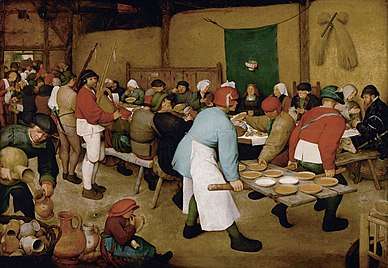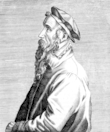The Peasant Wedding
The Peasant Wedding is a 1567 genre painting[1] by the Dutch and Flemish Renaissance painter and printmaker Pieter Bruegel the Elder, one of his many depicting peasant life. It is now in the Kunsthistorisches Museum, Vienna. Pieter Bruegel the Elder enjoyed painting peasants and different aspects of their lives in so many of his paintings that he has been called Peasant-Bruegel, but he was an intellectual, and many of his paintings have a symbolic meaning as well as a moral aspect.[2][3][4]
| The Peasant Wedding | |
|---|---|
 | |
| Artist | Pieter Bruegel the Elder |
| Year | 1567 |
| Medium | Oil on panel |
| Dimensions | 114 cm × 164 cm (45 in × 65 in) |
| Location | Vienna, Kunsthistorisches Museum |
Scene
The bride is in front of the green textile wall-hanging, with a paper-crown hung above her head. She is also wearing a crown on her head, and she is sitting passively, not participating in the eating or drinking taking place around her. The Bridegroom is not in attendance of the wedding feast in accordance to Flemish custom. The feast is in a barn in the summertime; two sheaves of grain with a rake recalls the work that harvesting involves, and the hard life peasants have. The plates are carried on a door off its hinges. The main food was bread, porridge and soup. Other features of the scene include two pipers playing the pijpzak, an unbreeched boy in the foreground licking a plate, the wealthy man at the far right feeding a dog by putting bread on the bench, and a mysterious extra foot seen under the load of dishes being carried by the two men in the right foreground. The scene is claimed to depict an accurate portrayal of the 16th-century way of celebrating a peasant wedding.[1]
The groom
There has been much conjecture as to the identity of the groom in this painting. Gilbert Highet has argued that the groom is the man in the centre of the painting, wearing a dark coat and seen in profile,[5][6] or the ill-bred son of a wealthy couple, seen against the far wall, to the right of the bride, eating with a spoon, same as Gustav Glück.[7] It has also been suggested that according to contemporary custom, the groom is not seated at the table but may be the man pouring out beer.[8] Or he may be according to the same custom serving the food instead. According to this theory, the groom is the young man wearing a red cap, who is serving his guests the food, handing out plates to his guests.[9]
In a Freudian vein, Rudy Rucker speculates:[10]
... the groom is the man in the red hat, passing food towards the bride. The motion of a husband, to penetrate the wife. Near him are no less than three phallic symbols pointing towards the wife: the man’s arm, the knife on the table, and the salt-cellar [salt shaker] on the table. At the end of the man’s arm is an ellipse of an angle-seen dish that is oriented and located in the right location to represent the bride’s vagina.[11]
Some authors have even suggested that the groom is not even included in the painting. Van der Elst speculated that this could be the depiction of an old Flemish proverb, like some of "There is an old Flemish proverb: 'It is a poor man who is not able to be at his own wedding.' That seems to be the case here."[12] Some argued that it is a presentation of the mystical Wedding of Cana.[4] Lindsay and Bernard Huppé speculated that the painting was a Christian allegory, symbolizing corruption, depicting the corrupted Church, which was supposed to be the bride of Christ, but the groom has not appeared to claim his corrupt bride.[13]
In popular culture
| External video | |
|---|---|
.jpg) | |
The painting was parodied in Asterix in Belgium.[14][15] Another parody was the postcard for the Belgian entry in the Eurovision Song Contest 1979.
Notes
- Pieter Bruegel the Elder's Peasant Wedding, c. 1566-69: Smarthistory, Art History at Khan Academy on YouTube
- "Paintings of peasant life (1567-68) by Pieter BRUEGEL the Elder". Web Gallery of Art. Retrieved 27 January 2015.
- "Bruegel, Pieter the Elder". Web Museum, Paris. Retrieved 27 January 2015.
- "The marriage at Cana" (PDF). Temple Gallery. Retrieved 27 January 2015.
- Gilbert Highet. 1945. Bruegel's Rustic wedding. American Magazine of Art 38. 274-276.
- Gilbert Highet. 1967. Where is the Bridegroom? Horizon: A Magazine of the Arts. 9.2:112-115.
- Gustav Glück, ed. 1937. Bilder aus Bruegels Bildern. Vienna: Verlag Von Anton Schroll & Co.
- Wied, Alexander; Van Miegroet, Hans J. "Bruegel". Grove Art Online. Retrieved 27 January 2015.
- "Helpings on the peasant wedding feast". Madame Pickwick Art. Retrieved 27 January 2015.
- "Rudy Rucker, Notes" (PDF). p. 54. Retrieved 27 January 2015.
- Rudolf von Bitter Rucker, As Above So Below. ISBN 0765327538.
- Joseph van der Elst. 1944. The last flowering of the Middle Ages. Garden City, NY: Doubleday, Doran & Company.
- K. C. Lindsay and Bernard Huppé. March 1956. Meaning and Method in Breughel's Paintings. Journal of Aesthetics and Art Criticism Vol. 14, No. 3. 376-386.
- Bell, Anthea (1996). "Translating Astérix". Translation: Here and There, Now and Then. Intellect Books. p. 129.
- Screech, Matthew (2005). Masters of the ninth art: bandes dessinées and Franco-Belgian identity. Liverpool University Press. p. 85.
Further reading
- Orenstein, Nadine M., ed. (2001). Pieter Bruegel the Elder: Drawings and Prints. The Metropolitan Museum of Art. ISBN 9780870999901.CS1 maint: extra text: authors list (link) (see index)
External links

